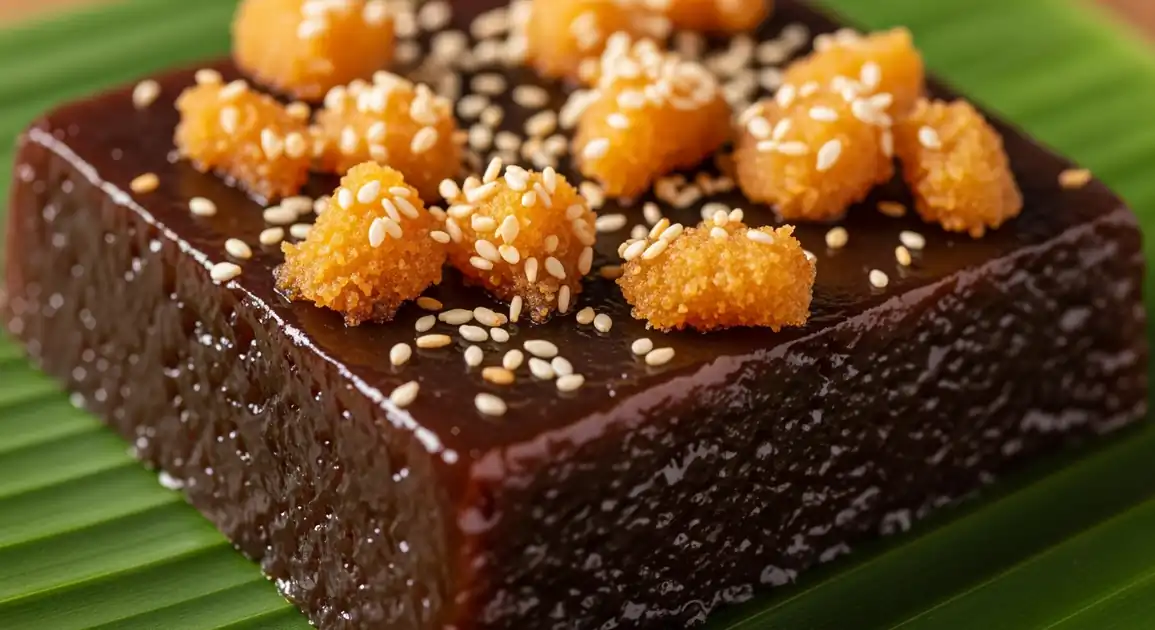Kalamay
Kalamay

Description
Bohol is the undisputed home of the most famous Kalamay variation in the Philippines - Kalamay Hati. Here, this sticky delicacy is elevated to iconic status, traditionally packaged in coconut shell halves sealed with bright red paper strips, making it both a cherished local treat and the island's signature souvenir food gift (pasalubong). Bohol Kalamay is distinguished by its darker color, thick consistency, and generous latik (coconut curd) topping.
Dietary Information
Serving information
Serving style
In Bohol, traditionally eaten directly from the coconut shell using a spoon. Often shared among family members or visitors as a sign of hospitality. Sometimes served with hot drinks to balance the sweetness.
Quick facts
Dedicated Kalamay shops typically operate from 8 AM - 6 PM. Market vendors start earlier (6 AM), while souvenir shops in tourist areas often extend until 8 PM or later.
Safety Tips
What to Look For
-
Properly sealed containers with no signs of mold or fermentation
For jarred or packaged Kalamay, ensure lids are tightly sealed without bulging. For traditional coconut shell packaging, check that the red paper strip is securely attached and unbroken.
-
Even, glossy appearance without excessive liquid separation
Quality Kalamay should have a consistent texture throughout. Some oil separation is normal, but excessive amounts indicate poor preparation or old product.
-
Clean, organized vendor setup with proper food handling
Especially important when buying freshly made or unpackaged Kalamay. Vendors should use clean utensils and maintain good hygiene practices.
-
Pleasant sweet aroma with caramel notes
Fresh Kalamay has a distinctively sweet smell. Any sour or fermented odor indicates spoilage.
What to avoid
-
Mold, unusual colors, or bubbling on the surface
These are clear signs of spoilage. Kalamay should have a uniform color without any fuzzy growths or spots.
-
Sour smell or fermented odor
Fresh Kalamay has a sweet aroma. Any sour smell indicates that fermentation has begun and the product should not be consumed.
-
Extremely runny consistency or very dry, cracked surface
Proper Kalamay is sticky and thick but spreadable. Too runny indicates undercooking or poor quality ingredients; too dry suggests it's old or improperly stored.
-
Damaged or improperly sealed packaging
Particularly important for jarred versions or traditional coconut shell packaging. Broken seals allow air and contaminants to enter.
Price information
Price range
Budget tips
- Standard coconut shell Kalamay averages 120-250 PHP depending on size and producer.
- Buy from producers in Jagna (known as the Kalamay capital) for authentic quality at better prices.
- Local markets like Tagbilaran Public Market offer lower prices (80-150 PHP) than tourist-oriented shops.
- Some specialty producers offer different sizes - smaller shells are more affordable souvenirs.
Value indicators
- Authentic coconut shell packaging with proper red paper seal.
- Rich, dark brown color indicating proper caramelization.
- Generous amount of latik (coconut curd) on top.
- Proper thickness and stickiness - neither too runny nor too dry.
- Products from established Bohol producers like Jagna makers generally justify higher prices.
Where to Find This Dish
Tagbilaran City
The provincial capital offers numerous souvenir shops and markets selling authentic Kalamay.
Island City Mall, BQ Mall, Tagbilaran Public Market, Dao Terminal, Tagbilaran Airport
10 AM - 7 PM
Jagna
Considered the Kalamay capital of Bohol, with numerous traditional producers creating the most authentic versions.
Jagna Public Market, Calamay producers along National Highway
Morning, Early Afternoon
Tourist Attractions
Souvenir shops at popular tourist sites across Bohol offer convenient (though sometimes pricier) options.
Chocolate Hills Complex, Loboc River area, Alona Beach, Panglao
Peak tourist hours (10 AM - 4 PM)
Vendor Tips
- Ask specifically for Jagna Kalamay if you want the most traditional and acclaimed version.
- Some specialty shops offer 'export-quality' versions with extended shelf life for travelers.
- For authentic experience, look for shops where you can observe the traditional packaging process.
- Check that the coconut shell packaging is properly sealed with the signature red strip.
How to Order
Regional Variations
-
Jagna Kalamay
(Kalamay sa Jagna)
Considered the gold standard of Bohol Kalamay, from the municipality of Jagna. Known for perfect consistency, dark color, and generous latik topping.
-
Albur Kalamay
(Kalamay sa Albur)
From Alburquerque town, typically prepared with a slightly lighter color and sometimes includes peanuts.
-
Trinidad Kalamay
(Kalamay sa Trinidad)
A distinct variation from Trinidad town, often incorporating additional ingredients like jackfruit or sweet potato.
-
Premium Boxed Kalamay
(Kalamay na naka-kahon)
Modern gift-ready packaging where traditional coconut shell Kalamay is placed in decorative boxes, popular for special occasion gifts and corporate giveaways.
Cultural context
History
Kalamay has deep roots in Filipino culinary tradition, with variations found across the country. The Bohol version (Kalamay Hati) gained particular prominence during the Spanish colonial period, when it became a specialty offering during religious festivities and later evolved into a sought-after pasalubong (souvenir food gift). The distinctive packaging in coconut shells sealed with red paper strips became tradition in Bohol, symbolizing good luck and prosperity. The labor-intensive preparation process, requiring hours of continuous stirring, has historically made it a communal cooking activity during celebrations.
Local significance
Kalamay is more than food in Bohol—it's a cultural symbol and source of pride. The traditional coconut shell packaging with red paper strip is immediately recognized as representing Bohol throughout the Philippines. Local families often have specific recipes passed through generations, and giving Bohol Kalamay as a gift carries special meaning.
Eating customs
- In traditional Bohol homes, offering Kalamay to visitors is considered a sign of hospitality.
- When eating from the coconut shell, it's customary to scrape the sides clean to enjoy all the caramelized portions.
- Locals often pair it with strong black coffee (kape) to balance the sweetness.
- The empty coconut shells are sometimes repurposed for crafts or as small containers.